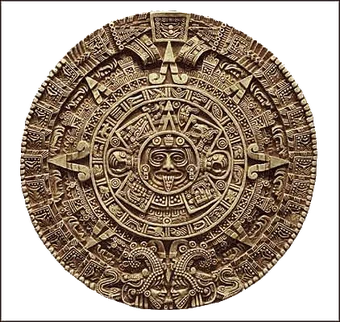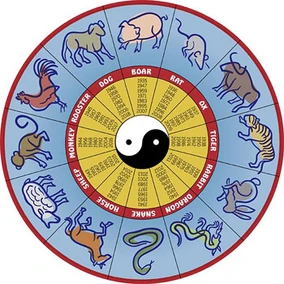In the Superpowers timeline, a distinct variety of Calendars have been developed by the five Great Powers. These methods for organizing the days of the year are all deeply rooted in the Ancient cultures of those societies, all of which developed in complete isolation from one another. For this reason, the calendar systems of each nation are very distinctive; often representing that state's developments in astronomy over time.
Calendars[]
Solar Calendar[]
This type of calendar is used by the Romans, Mayans and the Japanese. It is based on the period of revolution of the Earth around the sun, which is approx. 365 days. Every four years, an extra day was inserted to keep up with the irregularities. This year is often referred to as a leap year.

A Mayan calendar, preserved in the Museum Maianum in Teotihuacan
The Roman solar calendar has 12 divisions called months (though these have little relation to the moon), having 30 or 31 days, save for Februarius, the second month, which normally has 28 days and a 29th day is added every leap year. The months are named after Roman gods and important people, except the last four months. The order of the months of the Roman calendar is as follows:
- Januarius (named after the Roman god Janus, 31 days)
- Februarius (named after the Etruscan god Februus, 28 or 29 days)
- Marcus (after the Roman god of war, Mars, 31 days)
- April (scholars are unsure of the etymology, 30 days)
- Maia (after Maia, goddess of spring, 31 days)
- Juno (after the queen of the gods, 30 days)
- Julius (after Julius Caesar, 31 days)
- Augustus (after Augustus, first Roman emperor, 31 days)
- September (Septer means seven, 30 days)
- October (Octo means eight, 31 days)
- November (Novem means nine, 30 days)
- December (Decem means ten, 31 days)
On the other hand, the Mayan and Japanese solar calendars do not have such "divisions". Instead, they simply count the days from which the Earth is in the spring equinox until the next cycle, and so on.
Since Christianity is the state religion of the Roman Empire, the Roman calendar is often associated with the Christians, most notably the Roman Rite. It is used by Christians of many rites around the Roman Empire and around the world.
Lunar Calendar[]

The lunar calendar, used by the Muslims and the Incas, is based on the moon's cycles.
This type of calendar is based on the periodical cycles of the moon around the Earth, with each month lasting about 29 or 30 days. This type of calendar is most associated with the Muslims and the Incas.
The lunar year in the Islamic calendar has 12 months in a year, but the "year" has no relation to the movement of the Earth around the sun. Also, the lunar year is 11 days short of a solar year. Thus, the lunar year varies within the seasons. The month of Fasting, Ramadan, could happen in any season, and it takes 32 lunar years to return in a certain season. For example, if in this year Ramadan would be placed in summer, it will take 32 lunar years to make Ramadan return back to summer.
Luni-solar calendar[]

The Mongol World Empire's official calendar has elements of both the sun (Yang) and the moon (Yin)
This type of calendar combines features of lunar and solar calendars: i.e. "lunar months" fitted in a "solar year". The luni-solar year starts the new moon after the spring equinox. Normal luni-solar years have 12 months in a year. However, given the fact that the motions of the moon and the sun have irregularities, every two or three years an extra month is inserted. Such a year is called an "embolismic year".
Luni-Solar Calendars are used by the Mongol Empire, which the state philosophy emphasizes balance and harmony between the sun ("Yang") and the moon ("Yin"). Also the Coptic, African, and the Aramaic Christians use the luni-solar calendar, so do the Jews. The percentage of people using luni-solar calendars in the Roman Empire comprise a good 35% of the population. Luni-solar calendars are also of great popularity among astronomers over the world, as they claim that this calendar type helps them calculate new moons, and when to hold seasonal events.
Dating Systems[]
Not only do most nations have their own distinct calendars, but most of them date their years in their own way as well. However, the Roman dating system is by far the most universal and is currently in use by half of all nations on Earth.
Founding of Rome[]
The Imperium Romanum counts the year 753 BCE (OTL) as the year of Rome's founding. All the years before the founding of Rome are referred to as Ante Urbe Condita (PUC) and the years following as Ab Urbe Condita (AUC). In order to convert from the Anno Domini system to AUC simply add 753 to any Anno Domini year. For instance, for the year 2000 AD, add 753 years and you get 2753 AUC.
Birth of Genghis Khan[]
The year of Genghis Khan's birth is 1162 AD/ 1915 AUC. The Mongol World Empire s official dating system is based on Genghis Khan's birth. The years before 1162 AD/1915 AUC are referred to as Ante Genghis Rex (AGR, Rex meaning King in Latin) and the years following as Post Genghis Rex (PGR). Subtract 1162 from an AD year and you get the AGR equivalent. For example, subtracting 1162 from 2000 AD and you get 838 AGR, or 838 years after Genghis Khan's birth.
